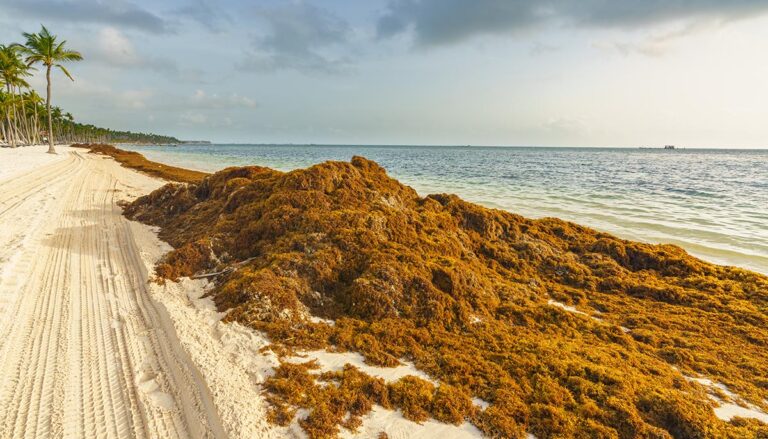A foul-smelling, 5,000-mile-wide seaweed blob floating in the Caribbean is already arriving in parts of Florida and has sparked panicked headlines right out of a 1950s horror/sci-fi flick, but authorities have a plan – will it work?
Seaweed monster: Massive, smelly blob washing up in Florida
Headlines such as: “Massive seaweed blob invades Florida beaches!” and “Huge, smelly snake of seaweed headed toward the Caribbean!” Have circulated this week right as the weather warms and people start to plan vacations.
According to reports, this blob of seaweed stretches 5,000 miles wide and is so large it can be seen from outer space. Early reports said it was in the Caribbean heading for Florida, but the latest news says it is already washing ashore, particularly in Key West, Click Orlando reported.
Just what is this blob
What the blob is in actuality is a type of floating brown seaweed, called sargassum, which is the common name or catchall term for more than 300 species of algae and marine plants that float along the ocean’s surface, CNN reported.
Sargassum is a critical habitat for a variety of small sea creatures, including crabs, mollusks, small fish, marine birds, and young sea turtles. It also protects shorelines from erosion, and acts as biomass for food, fuel, and pharmaceuticals, BuzzFeed News reports.
Sargassum has long formed large blooms in the Atlantic Ocean, with scientists tracking accumulation since 2011.
Under normal circumstances, sargassum isn’t harmful. But this year isn’t normal.
Massive blob could pose a major danger
However, this year’s patch is so large at 5,000 miles wide – about twice the width of the continental US – at that scale it is dangerous.
In large quantities, sargassum can turn from being an asset to marine life into a threat. In large quantities, it can suck the oxygen out of the water and create so-called “dead zones” for marine life.
The rotting algae also emit hydrogen sulfide, which smells like rotten eggs and is toxic and can cause respiratory problems. The seaweed also contains arsenic and is dangerous if ingested. This also presents a problem for cleaning beaches from the mounds of seaweed that washes up.
As the seaweed decomposes as it piles up and is left on the sand, in addition to releasing hydrogen sulfide, it also releases methane, ammonia, and other harmful gasses into the air that can cause respiratory problems.
The heavy metals such as arsenic and cadmium can be toxic to the skin, eyes, lungs, liver, and kidneys.
Large quantities of rotting sargassum can also support the growth of disease-causing germs, such as fecal bacteria.
Red tide beach evacuations
The sargassum blob isn’t the only problem Florida beaches are facing. In prior years, red tide algae blooms in Florida have led to a shutting down of beaches and evacuation of beachside businesses. It appears a similar problem is raising its head in March 2023, according to a local report saying, “You can’t go to the beaches.”
Florida has a plan to destroy the blob – will it work?
One option that is being tested on the seaweed blob in the Dominican Republic and Antigua is “sinking it offshore before it even gets close to land,” Florida Atlantic University Research Professor Brian Lapointe told Click Orlando.
“What you do, basically, you circle these large patches of Sargassum with a net, you bring it up to a big work boat and you sink it with a pump down to a point, a depth where the air bladders compress, and at that point, it becomes negatively buoyant and sinks to the bottom of the ocean, you know, a thousand meters or more down,” Lapointe said. “It locks away carbon fixed by the Sargassum that can chip away at the CO2 buildup in the atmosphere, something like carbon sequestration.”
However, Lapointe admits that, so far, the plan has not been very successful.
Lapointe said another plan was “putting booms out to try to hold it off the beach, and then harvest it along the booms.”
Whether scientists can defeat the massive algae blob to keep the beaches safe in Florida this summer remains to be seen.





